Therapeutic observation on lung-clearing and spleen-strengthening tuina in children with exogenous cough
Chen Li(陳莉),Wu Xi-jun (吳昔鈞)
WuxiHospitalof Chinese Medicine,Jiangsu 214000,China
Abstract
Keywords: Tuina;Massage;Pediatric Tuina; Cough;Exogenous Diseases; Clearing Lung;Strengthening Spleen; Child
Exogenous cough is a predominant in pediatric cough with high incidence. It most often occurs in winter and spring andcommonly affects infantsandtoddlers[1].Westernmedicineusedforpediatriccoughmay interfere with the immune function[2]. As an external therapy of Chinese meidicine, pediatric tuina (massage)helptodisperselungqi,resolvephlegmandstop coughs by stimulating specific acupoints. Since it is pain free and hasno side effects, it is easily acceptedby children and their parents[3].
Asfor thetreatment,themost commonly used meridians and points for exogenous cough in children include the Lung Meridian, Tiantu (CV 22), Danzhong (CV 17) and Feishu (BL 13), coupled with Kai-opening Tianmen,Tui-pushing Kangong,Tui-pushing Taiyang,Rou-kneading Erhougaogu to remove wind and release the exterior. All these methods aim to stop coughing from the ‘lung’[4-5]. The body constitution of children is different fromthatof adults.Because the spleenis weak in children, spleen and stomach play an important role in the treatment of pediatric diseases. The theory of treating coughfromthespleenhas alsobeen supported by related literatures. Liu YL,et al[6]used this theory to treat 40 cases with cough variant asthma (CVA)children. Pishu (BL 20) and Zusanli (ST 36) were selected to regulate the spleen and stomach. Fenglong (ST 40)andZhongwan(CV 12)were chosentofortify the spleen to resolve phlegm. The method was reported to haveatotaleffectiverateof 85%.Pan YY[7]applied traditional Chinese medicine to the navel for pediatric cough.Da Huang(Radix et Rhizoma Rhei),Zhi Shi(FructusAurantii Immaturus),TianZhu Huang(Concretio Silicea Bambusae),Ji Nei Jin(Endothelium Corneum Gigeriae Galli) andShen Qu(Massa Medicata Fermentata)were usedto strengthenthespleento disperse food stagnation. This method treated both the lung and spleen and achieved good results.
Inthis study,spleen-strengthening tuina manipulationswereaddedfor thetreatment of pediatric exogenous cough in children on the basis of lung-clearing tuina,including manipulations of Bu-reinforcingPijing,Qing-clearing Dachang,Mo- rubbing theabdomenclockwise,one-thumbTui- pushing Tianshu(ST 25),andAnrou-pressing and kneading Zusanli (ST 36). The report is given as follows.
1 Clinical Materials
1.1 Diagnostic criteria
Referring the diagnosis of cough inPediatric Tuina[8]:coughis themainsymptom;associatedsymptoms includenasalcongestionwithclear or turbidnasal mucus,fever,andpoor appetite;thick,rhonchusor moist crackles may be heard by lung auscultation; X-ray film shows normal or thickened lung texture.
1.2 Inclusion criteria
Confirmingto the syndromedifferentiationof traditionalChinesemedicine(TCM)for pediatric exogenous cough; under 7 years old; parents signed the informed consent and the child was able to cooperate for treatments.
1.3 Exclusion criteria
Cough caused by pneumonia, asthma, allergies, etc.
1.4 Statistical methods
Thedatawere processedusing the SPSS statistics 19.0. The measurement data that conformed to normal distributionwere describedasmean± standard deviation(±s),andt-test wasusedfor betweengroupcomparisons;thenon-normally distributed measurement data were expressed as median (lower quartile,upper quartile)[M(QL,QU)],andMann-WhitneyUtest wasused.Thecounting datawere processedby Chi-squaretest.P<0.05indicated statistical significance.
1.5 General data
According tothe diagnostic criteriaandinclusion criteria,77childrenwithexogenouscoughwere enrolled from thePediatric Outpatient Clinic of Wuxi Hospital of Chinese Medicine between September 2014 and October 2017. According to the random number table, they were divided into a treatment group and a control group, with39participantsin the treatment group and 38 cases in the control group.During the study, 1 participant in the treatment group and 2 cases in the control group dropped out. A total of 74 cases were finally included in the analysis, 38 cases in the treatment groupand36casesin thecontrolgroup.There wereno significant differencesin gender, age,and duration of disease between the two groups (allP>0.05),indicating that the twogroupswere comparable (Table 1). The clinical process of the two groups is shown in Figure 1.

Table 1.Comparison of general data between the twogroups
2 Treatment Methods
2.1 Control group
Routinelung-clearing tuinamanipulationswere applied to the patients in the control group.
Acupoints and applied regions: Feijing, Tiantu (CV 22),Danzhong (CV 17),Tianmen,Kangong,Taiyang (EX-HN 5), Fengchi (GB 20) and Feishu (BL 13).
Method: Vaseline was used as a massage medium topically. Thechildwas placedinasupineposition,
Qing-clearing Feijing manipulation was applied 100 times (Figure1)[9], and Tiantu (CV 22) wasRou- kneaded 200 times. Participants with excessive phlegm could be treated by An-pressing Tiantu (CV 22) heavily to induce vomiting, while the pressure intensity should be depending on their tolerance. Tuirou-pushedand kneadedDanzhong (CV 17)30 times[10],thenKaiopenedTianmen(Figure2),Tui-pushedKangong,Tui-pushedTaiyang (EX-HN5),andRou-kneaded Fengchi (GB 20) 50 times (Figure 3), respectively. After these manipulations, children took a prone or a sitting position,andthedoctor usedthehypothenar to Ca-scrub Feishu (BL 13) until slight heat sensation was generated locally[11].

Figure 1. Qing-clearing Feijing
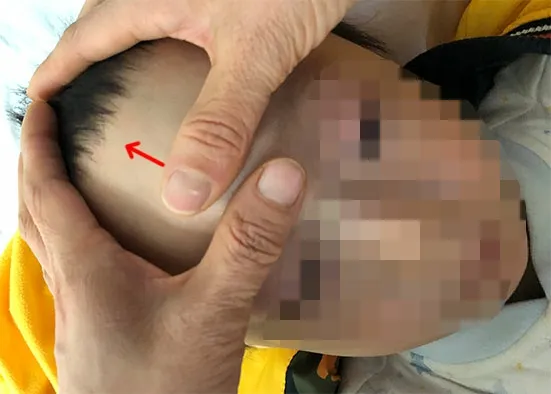
Figure 2.Kai-opening Tianmen
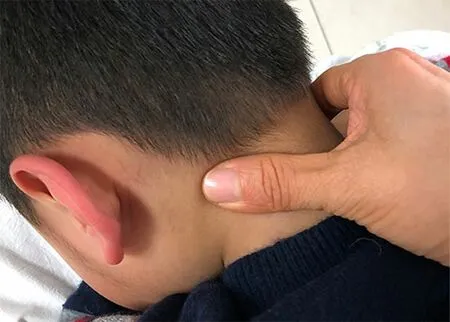
Figure 3. An-pressing Fengchi (GB 20)
2.2 Treatment group
Spleen-strengthening tuinamanipulationswere applied to the patients in the treatment group besides lung-clearing tuinamanipulations.The lung-clearing tuina manipulations were same as those used in the control group.
Spleen-strengtheningtuinamanipulations:Bu- reinforcing Pijing 300 times (Figure4),Qing-clearing Dachang 100times(Figure5),Mo-rubbing the abdomenclockwise5min,one-thumbTui-pushing Tianshu(ST 25)50times,andAnrou-pressing and kneading Zusanli (ST 36) 100 times (Figure 6).
Both groups were treated once a day, and 5 times constituted 1 treatment course.
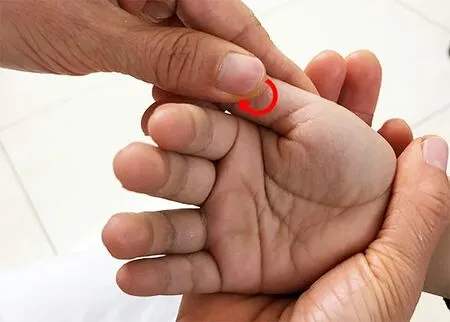
Figure 4. Bu-reinforcing Pijing
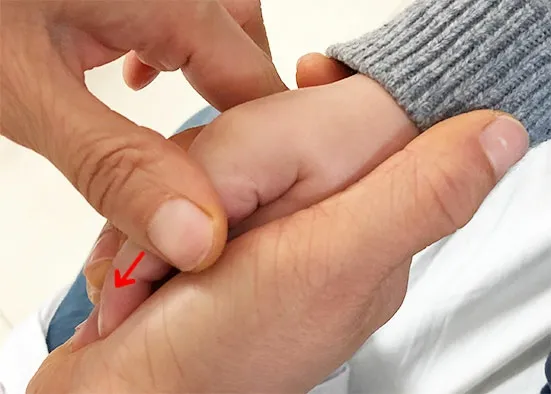
Figure 5. Qing-clearing Dachang
3 Therapeutic Efficacy Observation
3.1 Symptom score
Theself-madesymptomobservationitemswere observedreferring to theCriteria of Diagnosis and Therapeutic Effects of Diseases and Syndromes in Traditional Chinese Medicine[12].
Cough: 0 point for no cough; 2 points for 1 or 2 times of temporary cough; 4 points for more than 2 times of temporary cough; 6 points for frequent cough but not affecting daily life; 8 points for frequent cough affecting daily life; 10 points for severe cough seriously affecting daily life.
Fever:2points for severe;1point for moderate;0 point for normal.
Nasal congestion andphlegm: 2 points for severe;1 point for moderate; 0 point for normal.
Lossof appetite:2pointsfor severe;1pointfor moderate; 0 point for normal.
3.2 Criteria for clinical efficacy
Clinical recovery: Symptoms completely disappeared;symptom scores ≤2 points.
Markedly effective: Symptoms improved significantly,and the symptom scoresreducedby ≥2/3 compared with those before treatment.
Improvement:Symptoms improved,andthe symptom scores reduced by ≥1/2, but <2/3.
Failure:Noimprovementsinsymptoms,andthe symptom scores reduced by <1/2.
3.3 Results
3.3.1 Comparison of the clinical efficacy
After treatment, the total effective rate was 89.5% in the treatment group versus 75.0% in the control group,showing astatistically significant difference (P<0.05).Thetherapeutic effectof lung-clearing plusspleenstrengtheningmanipulations is better thanthat of lung-clearing tuina alone. Please see Table 2 for details.3.3.2 Comparison of symptom scores
After treatment,therewerestatistically significant intra-group differences in all symptom scores in the two groups (allP<0.05). There were statistically significant differences in the scores of cough and loss of appetite between the two groups(bothP<0.05).It suggested that theeffect of lung-clearing plus spleenstrengthening tuina manipulation was better than that of lung-clearing tuina alone in improving appetite and cough. Please see Table 3 for details.

Table 2.Comparison of clinical efficacy between the two groups (case)

Table 3.Comparison of symptom scores before and after treatment between the two groups [M (QL, QU), point]
4 Discussion
Clinically, exogenous cough in children occurs along withphlegm.Dry coughisrare,becausethelung,spleen and kidney in children are not fully developed. In children,thelung isdelicateandsusceptibletobe affectedby exogenous pathogens.Theascending of lung qi causes cough. The weakness of spleen causes the generation of phlegm. Consequently, cough is not only associated with lung, but also closely associated withthespleen.Resolvingphlegmis importantfor exogenous cough in children. Exogenous cough can be differentiatedinto twopatterns:wind-coldand wind-heat[13].Due to the special yang constitution of children,pathogenic factors(including cold)tendto transformintoheat[14],thetreatmentstrategy is to apply lung-clearing andphlegm-resolving tuina manipulations regardless wind cold or wind heat.
Pediatric tuina stimulates the acupoints to unblock themeridianstoregulatefunctionsof theZang-fu organs[8]. Lung-clearing tuina method can clear the lung andresolvephlegm;Tiantu(CV 22)andDanzhong (CV 17) can regulate qi, resolve phlegm, stop cough and alleviate panting. An-pressing Tiantu (CV 22) heavily can induce vomiting toexpelphlegm[15]. The four major manipulationsfor theheadandface[16]include Kai-opening Tianmen, Tui-pushing Kangong, Tui-pushing Taiyang andRou-kneading Erhougaogu.These manipulations can remove wind and coordinate yin and yang.Feishu(BL 13)is locatedintheback,and corresponds to the lung. Ca-scrubbing Feishu (BL 13)can clear the lung, regulate qi and relieve cough and phlegm[17].Stimulating Feishu(BL 13)canenhance respiratory functionandincreaselung ventilation[18].Theclinicalefficacy of lung-clearing plus spleenstrengtheningmanipulations is better thanthat of lung-clearing tuinaalone.Inaddition,ithas better effect in relieving cough and improving appetite.
Phlegm is a pathological product of cough, and at the same time, an etiological factor. In nature, cough is a protective defensive reflex of the human body and a normalprotectivemechanism[19].Coughcanexcrete pathological products produced by the lungs. In both traditionalChinesemedicine andWesternmedicine,the treatment strategy for coughinchildrenis to resolve phlegm rather than to stop cough. There are two ways to resolve phlegm. One is to induce vomiting toexpelphlegmout of themouth.Most children,especially infants, do not know how to spit. For them,the other method is to resolve phlegm through bowel movements.Themanipulations of Mo-rubbingthe abdomenclockwise,one-thumbTui-pushing Tianshu(ST 25)andQing-clearing Dachang usedinthe treatmentgroupcanpromote theemptying of the gastrointestinal tract and accelerate the excretion of the phlegm[20-22].
Chinese medicine believes that the human body is an organic whole[23], and treatment should follow a holistic view and treat patients from the origin. The spleen is the source of phlegm. The spleen and stomach are not fully developed in children. Spleen deficiency may cause dampness,andover time,accumulateintophlegm.According to thefive-element theory,thelung is associated with the metal while the spleen is associated with earth. Tonifying the spleen can reinforce earth to generate metal, therefore improving the clinical efficacy for cough. The spleen and stomach are the acquired foundation of the body. Rou-kneading Zusanli (ST 36)and one-thumb Tui-pushing Tianshu (ST 25) can tonify the spleen and stomach to regulate qi and blood[24]. By regulating the spleen and stomach, it can promote and regulate the functions of Zang-fu organs. When qi and blood function well, digestion is regulated,meridians are unblocked,andyinand yang areinabalance,various diseases will disappear[25].
Spleenandstomacharevitalfor children.Paying attentiontothespleenandstomachand simultaneously adjusting thelung andspleencan improve the clinicalefficacy for exogenouscoughin children. This also provides ideas for the treatment of lung diseases such asrepeatedrespiratory infections and cough variant asthma in children.
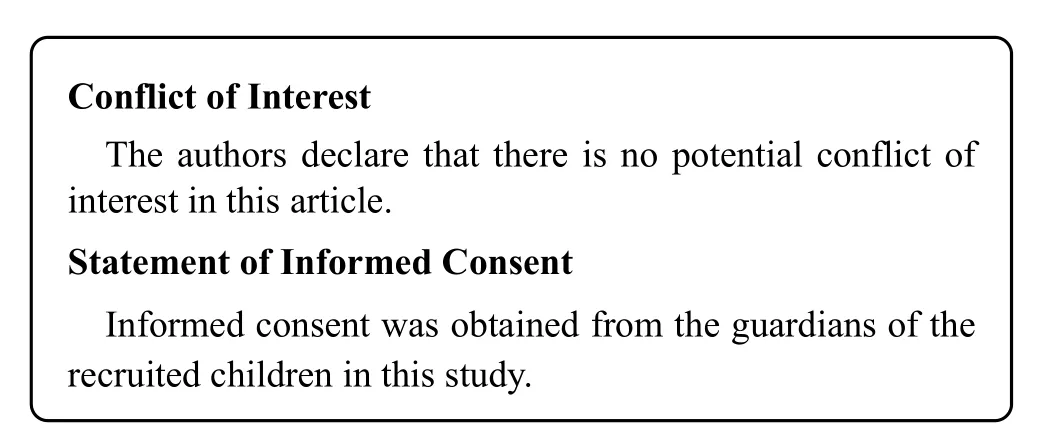
Conflict of Interest The authorsdeclare that there isnopotential conflict of interest in thisarticle.Statement of Informed Consent Informed consent wasobtained from the guardians of the recruited children in thisstudy.
Received:30October 2019/Accepted:11December 2019
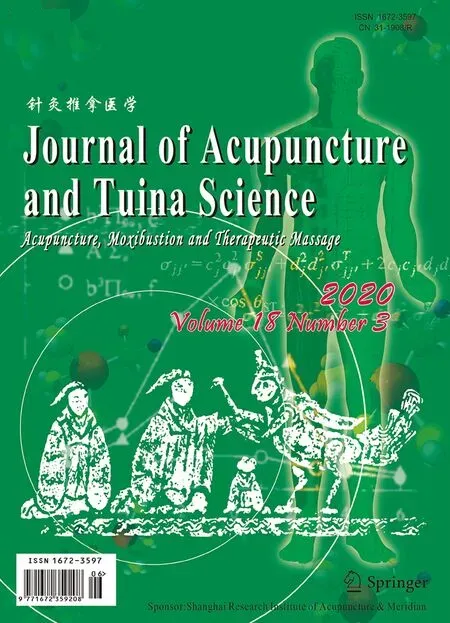 Journal of Acupuncture and Tuina Science2020年3期
Journal of Acupuncture and Tuina Science2020年3期
- Journal of Acupuncture and Tuina Science的其它文章
- Analysis of clinical application patterns in acupuncture-moxibustion treatment of Alzheimer disease
- Therapeutic observation of manipulation plus exercise therapy in treating upper crossed syndrome postures of primary school students
- Clinical observation on heat-sensitive moxibustion plus lactulose for postoperative constipation of mixed hemorrhoid due to spleen deficiency
- Therapeutic effect of heat-sensitive moxibustion plus medications for senile osteoporosis and its effect on serum BMP-2 and OPG levels
- Effects of electroacupuncture plus drug anesthesia on pain and stress response in patients after radical surgery for stomach cancer
- Therapeutic efficacy observation on auricular point sticking therapy for cardiac syndrome X in women
